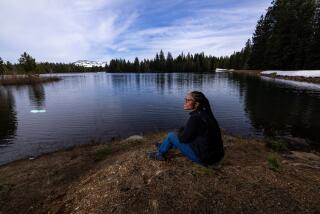Richard H. Goodwin, 96; leader in land conservation
- Share via
Richard H. Goodwin, a pioneering land preservationist and early president of the Nature Conservancy who negotiated the conservation group’s first land purchase in California, a 3,000-acre stretch of virgin forest along the state’s northern coast, has died. He was 96.
Goodwin, who was a longtime botany professor at Connecticut College, died July 6 in East Lyme, Conn., the college announced. No cause of death was given.
“His visionary leadership in land conservation established the foundations for not only the conservancy but the modern conservation movement,” Steven J. McCormick, chief executive of the conservancy, said in a statement.
At the time of its purchase in 1959, the acquisition of the California expanse now known as the Angelo Coast Range Reserve was the largest land-trust deal in the conservancy’s brief history. The property also became the organization’s first preserve in the western U.S., said Shari Cravens, a spokeswoman for the conservancy’s program in California.
The conservancy has now either purchased or helped protect 1.2 million acres in California.
The original land deal came about largely because of a philosophy of Goodwin’s -- that the key to conservation is to find and make overtures to people who love their land -- and his gentle yet iron-willed approach. Goodwin felt that strong business principles were key to land conservation. He told Investor’s Business Daily in 2001 that many scientists and other parties interested in acquiring land failed because they didn’t “act like real estate agents.”
Goodwin approached retired Mendocino County businessman Heath Angelo, who was looking for a conservator for the property, and persuaded him to sell the land for $100,000. His Connecticut College students donated the first $10 to buy it.
Over the years, Angelo complained that the conservancy was not spending enough on upkeep and protested by refusing to accept final payment for the land. But Goodwin kept calling and visiting, and, 15 years after the initial transaction, convinced Angelo to take the last check.
“If you really want to get something done, start on it, keep at it, and it will eventually happen,” a then 90-year-old Goodwin told Investor’s Business Daily. “Some of the biggest, most interesting preserves that have come about didn’t happen overnight.”
Goodwin brought the same “quiet grit” to his leadership of the nonprofit, according to “Nature’s Keepers,” a 2005 book on the conservancy’s history.
After helping to found the organization in 1951, Goodwin served as its president twice, from 1956 to 1958 and 1964 to 1966. He was its last unpaid chief executive.
Membership has grown from 2,500 members in 1956 to about 1 million today. The conservancy has either purchased or helped protect 15 million acres in the U.S. and an additional 10 million acres around the world.
Richard Hale Goodwin was born Dec. 14, 1910, in Brookline, Mass., the only child of Harry and Mary Goodwin.
Raised in Brookline, near Boston, Goodwin suffered from bronchitis and asthma and often traveled west in an attempt to improve his health.
He started “caring about the environment and thinking about future generations” as a teenager railroading through Minnesota when he saw a fire-damaged forest, he told the Hartford Courant in 1998.
Goodwin studied forestry, zoology and botany at Harvard University, earning bachelor’s and master’s degrees in biology. He also received his doctorate in biology with a concentration in botany from the school in 1937.
He married the former Esther Bemis in 1936, and the couple honeymooned in Africa and climbed Mt. Kilimanjaro.
Since 1965, the couple had lived full-time in a glass-walled house in the middle of a conservancy preserve that Goodwin helped begin in East Haddam, Conn.
They bought the 170-acre farm in 1956, then added more acres before entrusting it to the conservancy.
In 1938, Goodwin made his first purchase as a conservationist when he brokered the deal for five acres of a swamp in upstate New York for $125. Most of the 20,000-acre swamp is now a preserve.
After teaching botany for several years at the University of Rochester, he joined Connecticut College, a private liberal arts college in New London, Conn., in 1944 and headed the botany department for 32 years.
At the college, Goodwin helped create an early environmental studies programs. He also researched the physiology of root growth, florescent compounds in plants and the effects of light on plant growth.
Under his direction, the college’s arboretum expanded from 90 acres to more than 400 before he retired in 1976.
The Connecticut College Goodwin-Niering Center for Conservation Biology and Environmental Studies was named in in honor of Goodwin and William Niering, his botany department colleague.
Goodwin and Niering co-founded the Connecticut chapter of the Nature Conservancy. The pair often employed a low-key yet fruitful negotiating tactic. “We’d visit a farmer and sit in rocking chairs in his kitchen and rock and rock,” Niering told Nature Conservancy magazine in 2001, “until we finally got a price out of him.”
In addition to Esther, his wife of 70 years, Goodwin is survived by a daughter, Mary Linder Wetzel; a son, Richard H. Goodwin Jr.; four grandchildren and two great-grandchildren.
More to Read
Sign up for Essential California
The most important California stories and recommendations in your inbox every morning.
You may occasionally receive promotional content from the Los Angeles Times.











